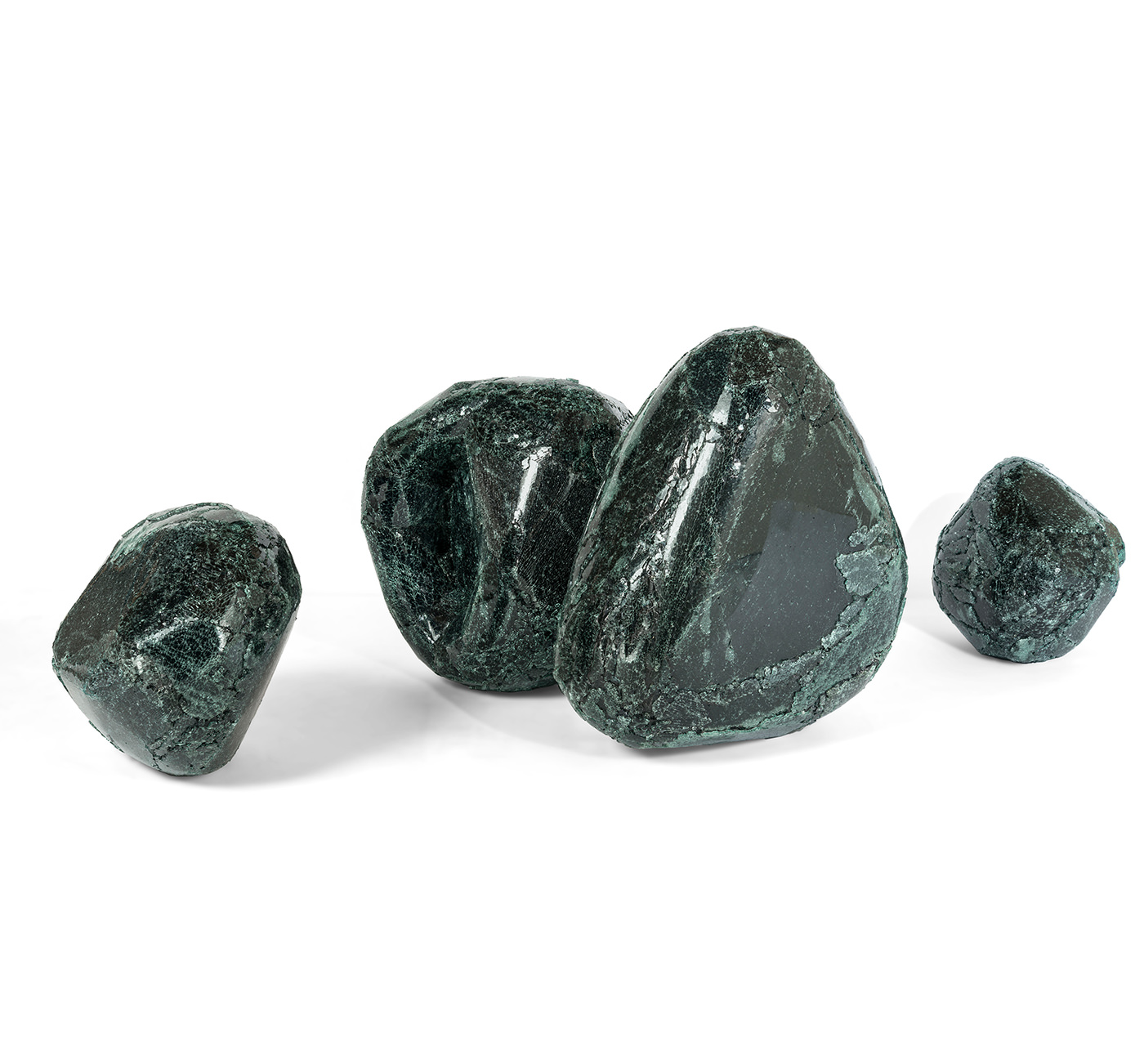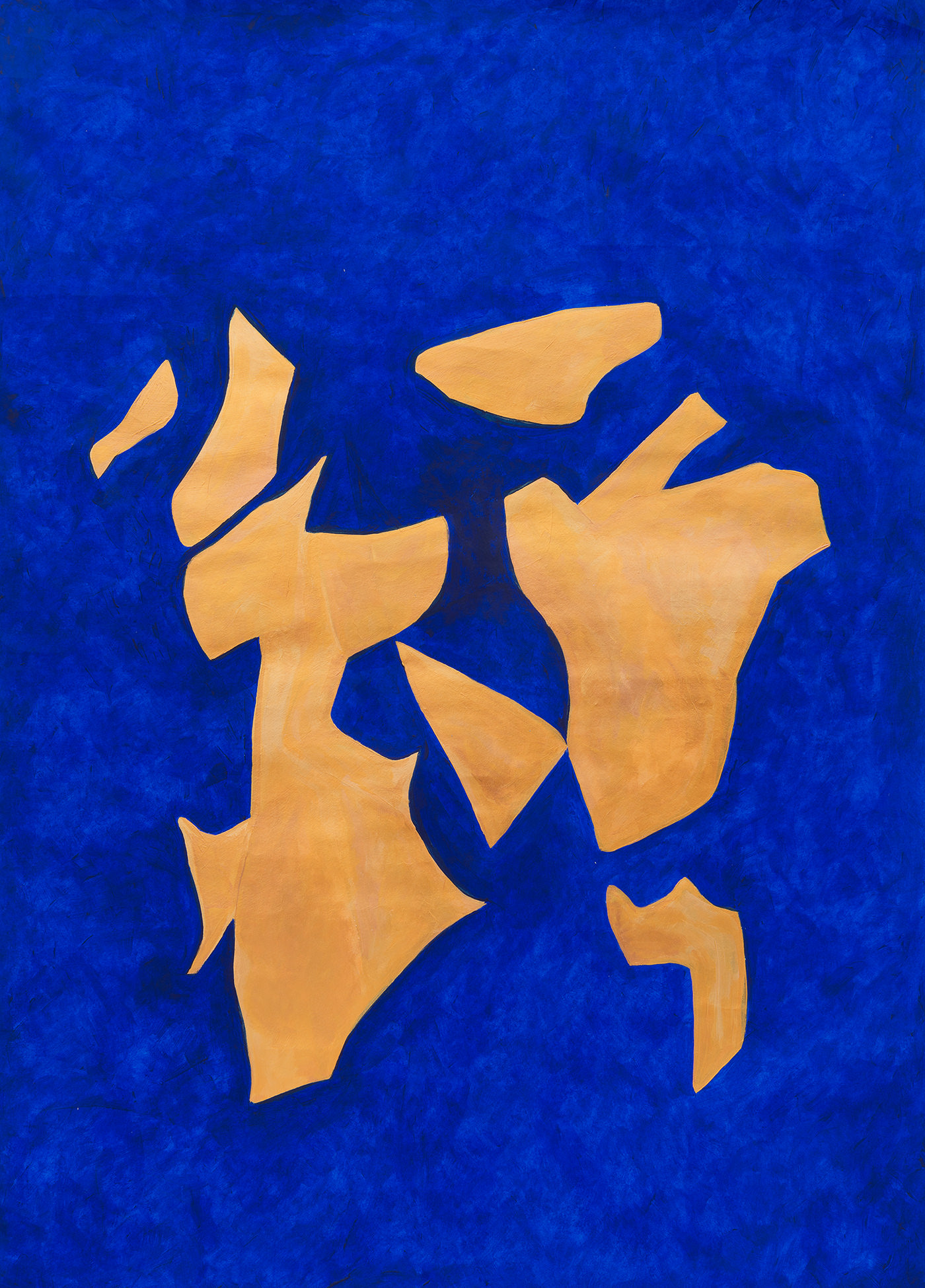Adriana Carambia
Maggio 2019
La bellezza delle cicatrici Su “Frammentario” e “L’inganno della luce”
Una pelle che può essere tanto superficie ornamentale quanto terreno da nominare, spazio che si colonizza e si spartisce. I frammenti possono essere indefiniti, smemorati; isole che hanno smarrito la loro relazione con l’oceano, tracce che sussistono appena, velate da strati successivi di acrilico metallizzato. L’oceano ѐ immensità dorata, moneta ramata, azzurro iridescente, cartografia ocra. A volte le isole sono appena ritagli, rossi coagulati nelle loro ansie di sensualità che vibrano stridenti nella landa. Altre, i contorni del frammento si distinguono appena, come quando un tenue bagliore li rischiara un attimo prima della loro scomparsa. I bordi si estendono per raggiungere altre coste: sentir nostalgia del continente ѐ una maniera di andare avanti, di proseguire oltre.
Le opere in carta che Adriana Carambia raccoglie sotto il titolo “Frammentario” sono un po' come vetri rotti i cui pezzi sono stati separati e mescolati, reliquie preziose che non sanno più inserirsi in un presente dove la bellezza ha perso la raffinatezza originale per mostrarsi siliconata e immobile. Si tratta di gesti, la maniera in cui il gesto si fa silenzioso e tuttavia si fa ancora sentire, resiste l’esser fatto tacere. In queste grandi opere il gesto pittorico compare come uno stimolo, una silenziosa ribellione che lotta per espandersi.
Risulta rilevante costatare le affinità e le divergenze tra il gesto che muove i dipinti frammentari e quello che anima le sculture della serie “L’inganno della luce”. La lavorazione di queste pietre di vetro ѐ difficile e pericolosa. Carambia si occupa in primo luogo di trovare il materiale: si tratta di un vetro polarizzato che corrisponde ai finestrini delle auto che hanno subito un incidente (“vetri post-trauma” li chiama l’artista). Tale materiale da scarto viene intercettato per essere trasformato in pietra. La pietra è una riserva geologica di segreti e di storie e nella sua forma autosufficiente è un mistero. Il materiale dev’essere manipolato con cura e delicatezza, ben ripulito per far risaltare la sua luminosità, il colore approfondito con azzurro di Prussia. Il vetro scheggiato è anche qui come una pelle che verrà a coprire il corpo intagliato precedentemente. Le fratture del materiale non sono dissimulate ma, al contrario, le cicatrici vengono esaltate: sono i segni delle battaglie combattute dall’oggetto nell’arte di sopravvivere.
Juan Eduardo Cirlot chiamò la pietra “la musica pietrificata della creazione”. “La pietra è un simbolo dell’essenza, della coesione e la conformità con sé stessi. La sua durezza e durabilità impressionarono gli uomini di ogni tempo, che videro nella pietra il contrario della biologia, sottomessa alle regole della mutazione, l'invecchiamento e la morte, e anche il contrario della polvere, la sabbia e la ghiaia, aspetti della disgregazione. La pietra intera fu simbolo di unità e forza; la pietra rotta in tanti frammenti, lo smembramento, la scomposizione psichica, la malattia, la morte e la sconfitta”, spiega Cirlot.
Mentre il gesto delle carte “Frammentario” segnala la scomposizione della forma chiusa, la disarticolazione dei piani, evocando sensazioni di fluttuazione, sovrapposizioni leggere, sfasamenti e isolamenti, nelle pietra il gesto è inverso: si tratta in questo caso di ristrutturare un piano scheggiato, di consolidare quello rotto e offrire alle conseguenze di un sinistro una nuova destinazione, racchiudendolo in una forma contenitrice. La resilienza del materiale è l’energia di deformazione che può essere riutilizzata. In questa nuovo apparire, le cicatrici rifulgono, belle e reminiscenti.
Verónica Gómez
February 2019
The beauty of scars
On “Fragmentary” and “The Trap of the Flash”
A skin which is both an ornamental surface and a territory as yet unnamed, a space which is colonized and divided. The divisions can be uncertain, forgetful; islands which have lost their relationship with the ocean, lines which only just survive, veiled by successive layers of metallic acrylic. The ocean is a gold immensity, copper coined, iridescent blue, cartography ochre. At times the islands are just fragments, coagulated reds in their yearning sensuality, vibrating stridently on the wasteland. Others, the shapes of the fragment are just visible as if a soft light was showing them a second before they disappear. The corners stretch, wanting to reach other coasts: missing the continent is a way of advancing.
The papers which Adriana Carambia groups under the title “Fragmentary” has some shards of glass whose splinters have been separated and mixed, palatial relics that no longer know how to fit into a present where beauty has lost its handcrafted sophistication to a silicone permanent one. It is about gestures, the way a gesture is silenced or still murmurs, defiant to being quietened. In these large papers the pictorial gesture appears as a tingle, a silent rebellion which strives to spread.
It would be relevant to confirm affinities and divergences between the gesture that moves the fragmentary paintings and the one that animates the sculptures from the series, “The Trap of the Flash”. The process of these glass stones is arduous and dangerous. Carambia first attends to obtaining the material: polarized glass from car windows following accidents (“post-trauma windows”, the artist calls them). This discarded material is intercepted so as to turn into stone. Stone is a geological reservoir of secrets and history and in its self-sufficient form is a mystery. The material must be handled painstakingly and with care, its shine highlighted and polished, the colour deepened with Prussian blue. The shard of glass here is also a skin which will trace the previously carved body. The fractures of the material are not concealed, on the contrary: the scar is exalted; these are the marks of battle which have freed the object in the art of survival.
Juan Eduardo Cirlot called stone “the petrified music of creation”. “Stone is a symbol of being, of cohesion and conformity with oneself. Its hardness and longevity have always impressed men, those who saw the contrary to the biological in stone, submissive to the laws of change, decline and death, but also the contrary to dust, sand and gravel, aspects of disintegration. A whole stone symbolized unity and strength; a stone broken in fragments, dismemberment, mental disintegration, disease, death and defeat”, explains Cirlot.
While the expression in the “Fragmentary” papers shows the decomposition of the closed form, the disarticulation of the flat surfaces evokes sensations of floating, light overlapping, misalignment and isolation, in the stones the expression is the opposite: the restructuring of a splintered plane, of the consolidation of the broken, offering a new destiny to the aftermath of a catastrophe by closing it in a contained manner. The resilience of the material is the energy of deformation to be reused. In this new appearance, the scars glow, beautiful and memorable.
Verónica Gómez
February 2019
Arkè - Galleria d'Arte Moderna e Contemporanea - San Marco 3211 - Venezia 30124 - tel-fax 0415224372 - cell 347.7158548 Privacy Policy - Cookie Policy
web: Luca De Luigi
email: g_rizzetto@hotmail.com - facebook - instagram














